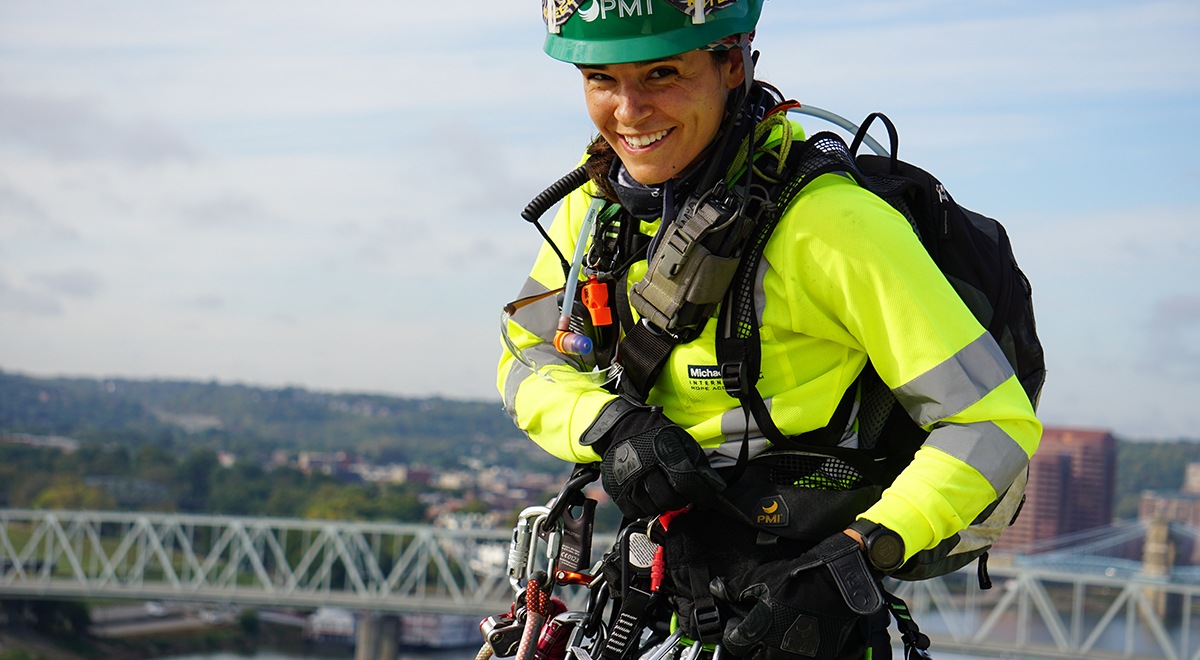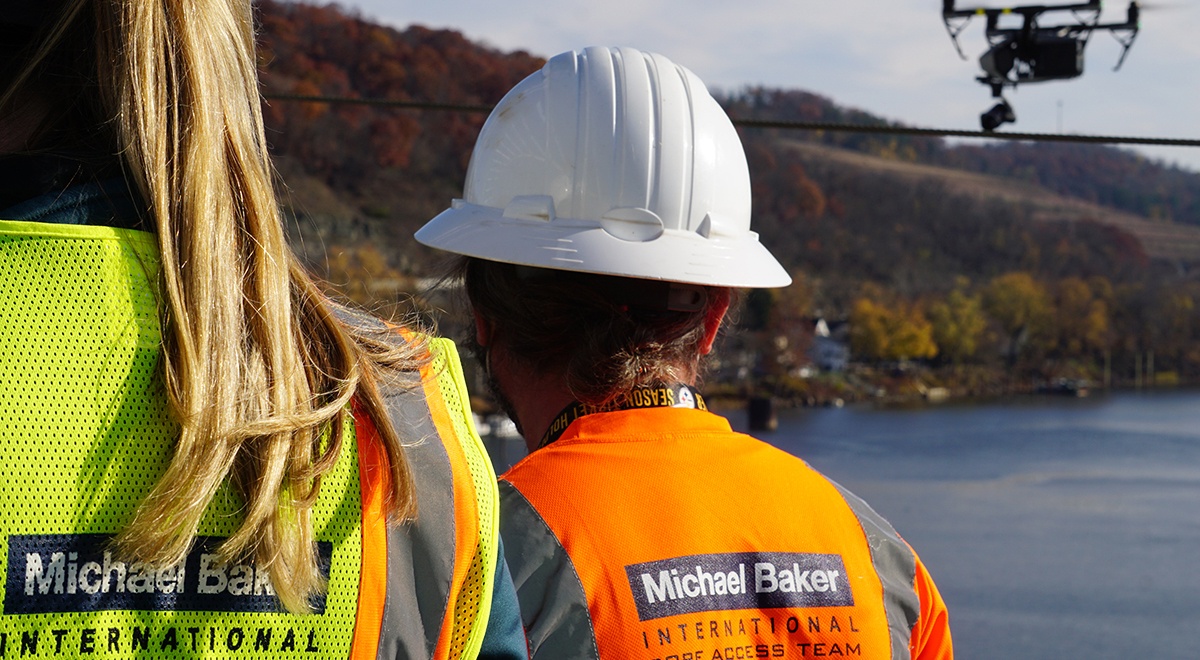From the Summer 2021 issue of Signature
Whether moving people or freight, rail and transit solutions are integral to our country’s economic vitality. Commuter rail, especially electric-powered rail, is both energy efficient and safe. As America’s economy grows, the need to move more freight will grow too. The Federal Highway Administration forecasts that total U.S. freight shipments will rise from 18.6 billion tons in 2018 to 24.1 billion tons in 2040 — a 30% increase. To learn more about where the field is going, we caught up with Michael Baker International’s Rail and Transit Specialty Practice Leads, Ed La Guardia P.E. (Passenger Rail and Transit) and Kirsten Bowen P.E. (Freight Rail).
What impact do you see investments in a new generation of transportation systems having on our cities and suburbs?
La Guardia: I think Transit Oriented Development (TOD) — which are pedestrian-oriented, mixed-use communities centered around high-quality transit systems — will be increasingly important. A significant example is the CTfastrak system in Connecticut from New Britain to Hartford. CTfastrak is the state’s first Bus Rapid Transit (BRT) system that uses a dedicated bus-only roadway to connect riders with major regional employment and transportation, retail and healthcare destinations — so the bus is essentially a rubber tire train. TOD has all sorts of benefits, from making cities more livable and enhancing access to job opportunities, to reducing highway congestion, lowering our carbon footprint and improving connectivity and time savings.
Also, multimodal integration — for example, the Jacksonville Regional Transportation Center — creates a more seamless connectivity between multiple transportation modes and will have a positive impact in our communities. Performing network analysis for multimodal integration, including heavy rail, light rail, BRTs and shared mobility services like bike- and ride-sharing (Uber, Lyft), will help provide first- and last-mile connectivity. It’s all about how to make a two-seat ride more connected and user friendly by using the existing infrastructure to analyze the scheduling integration of the different modes.
What can transit agencies do to attract new riders as the country emerges from the pandemic?
La Guardia: I think Millennials can be credited for a lot of the growth in ridership that had taken place before the pandemic, as many have opted away from suburban life in favor of urban neighborhoods where they can easily take a train or bus to get around. That demographic has a big influence on shaping transportation considerations and how we look at transit usage. They generally have a “less is more” approach, value public transit over personal auto ownership, and prefer to live near work where they can bike, walk and use ride-sharing services.
In addition to multimodal integration, transit agencies need to think about information integration and take advantage of smartphone technology that can provide real-time information to riders about their connectivity options, routes, schedules and fares. In addition, “bus network redesigns” — the process of looking at and reworking a public transit service area in its entirety — is a significant need in terms of better serving existing riders and attracting new riders. Bus network redesigns have occurred across the country and allowed transit authorities to maintain or even regain ground in what was a declining market share in the industry.
Given the rise of e-commerce, how do you see transportation and logistics providers evolving?
Bowen: E-commerce continues to grow each year and accelerated with the pandemic. While it’s a major convenience for consumers, it means more responsibility for logistics and supply chains.
I’ll be the first to admit that Amazon has a big influence on my expectations — that when I place an order, a package will show up the next day and I know exactly where it is and how many stops are remaining. I think this technology is going to catch up with the transportation and logistics providers, where there will be an online GPS-based system to track all customer, loading and product data in real time — just like with Amazon. A big challenge with this is that not all railroads use the same technology. So, if you are shipping goods from California to Florida, they will transfer between multiple carriers, and the interface between the carriers will be different, so a customer will have to log into multiple websites to find information. It is a challenge that the industry will have to overcome.
What other trends do you believe will transform freight transportation in the near and long term?
Bowen: I think the COVID-19 pandemic exposed vulnerabilities of the supply chain, particularly suppliers relying on specific products overseas. One positive that may come out of the pandemic is that companies will reassess manufacturing for critical items and there is potential for an increase in manufacturing in the United States. Additionally, to accommodate potential changes in manufacturing and consumer demands, freight railroads will continue to invest in technology, streamlining operations and modernizing their networks and services.
What are some of the most exciting projects you and your team are currently working on?
La Guardia: In Philadelphia, we recently won a contract with the Southeastern Pennsylvania Transportation Authority (SEPTA) on its bus network redesign program. Michael Baker, along with a specialty transportation planning firm, will evaluate SEPTA’s entire bus system relative to the way the lines were established as legacy lines, overlay how the regentrification of Philadelphia has occurred and how that has impacted the lines, and then recommend how to change them to fit the way Philadelphia looks today. Over the next two years, our assignment is to assess the entire network and determine how to make SEPTA’s 1,400-bus fleet work more efficiently for the population density in the city now — which is a fascinating project to undertake.
We’re also providing program management support for SEPTA’s $2 billion King of Prussia rail line extension project that will extend the existing Norristown High Speed Line (NHSL) four miles into King of Prussia, providing a highspeed, “one-seat” ride from any station along the NHSL. Additionally, we recently conducted the preliminary study for the addition of two tracks crossing the Potomac at Long Bridge — a series of bridges connecting Washington, D.C., to Arlington, Virginia, over the Potomac River. In fact, it’s the only rail route across the Potomac into Washington, D.C., for freight and passenger service. It’s currently a two-track railroad that carries overwhelming train traffic, including Amtrak, Virginia Railway Express, CSX and Norfolk Southern.
Bowen: Our freight rail team is currently working on several bridge rehabilitation projects. These projects typically include inspection and load rating, emergency and planned replacements and vertical clearance projects. One recently completed project was the result of an emergency flooding incident where we mobilized to the site, installed a monitoring system to maintain safe operations, and designed a replacement structure for the bridge to be replaced within a year of the incident.
We are also currently servicing Norfolk Southern and CSX through general engineering contracts. I enjoy working with these two clients because their projects are fast-paced and far-reaching. Often, the schedule is dictated by a funding source or a potential customer, and our team might only have a few months to complete the design phase, which is exciting because these projects get under construction quickly and we’re able to see how our design is getting implemented. Also, their infrastructure covers the eastern half of the country, which enables us to workshare within our various offices, leveraging our local expertise with our rail expertise.
Kirsten, you were previously named the WTS International Member of the Year for your commitment to advancing women in the transportation industry. How do you see women continuing to evolve their roles and prominence in the transportation industry?
Bowen: For more than 40 years, WTS International has been dedicated to building the future of transportation with the global advancement of women through mentoring and networking opportunities. I believe organizations like WTS will continue to be instrumental as we all emerge from these unprecedented times. The pandemic has challenged everyone, but particularly women in the workforce due to balancing childcare, home schooling and careers. Some studies say four times as many women as men dropped out of the labor force last year as a result of the pandemic. I think there will be a greater emphasis placed on attracting and retaining women in transportation beyond the pandemic to ensure the sector has a truly diverse workforce. It’s critical that we all support other women and to give and seize opportunities to advance their careers — that will truly be the way the transportation industry will become more gender-inclusive.
About Kirsten Bowen
Kirsten Bowen, P.E., is Specialty Practice Lead – Freight Rail for Michael Baker International. She is responsible for positioning the practice for growth and leading a team of experts to deliver innovative solutions that modernize the country’s freight rail infrastructure.
Bowen has been an integral part of Michael Baker for 20 years. She has extensive experience in the design and project management of transportation projects, including railyards, rail and highway infrastructure and multimodal facilities.
Bowen earned a master’s degree in Urban Planning, Design and Development from Cleveland State University and a Bachelor of Science degree in Civil Engineering from Case Western Reserve University. She currently serves as the Vice Chair of the American Railway Engineering and Maintenance-of- Way Association’s (AREMA) Committee 14 — Yards and Terminals and is an active member of the Women’s Transportation Seminar (WTS International) and the American Society of Highway Engineers (ASHE).
About Ed La Guardia
Ed La Guardia, P.E., is Michael Baker International’s Specialty Practice Lead – Passenger Rail and Transit. He is responsible for facilitating the company’s ongoing growth and expertise in Passenger Rail and Transit.
La Guardia has more than 35 years of industry experience, including 13 as SEPTA’s Chief Engineer before joining Michael Baker in 2014. He is widely recognized as an expert in the Rail and Transit field, both locally and nationally, with extensive knowledge in operations, engineering, design, program management and construction management.
La Guardia earned his Bachelor of Science in Engineering Technology degree in Civil/Structural Engineering from Temple University. Nationally, he is active in AREMA Committee 11 (Commuter & Intercity Rail Systems), the American Public Transportation Association Rail Transit Committee and is currently the Chair of the Elevator/Escalator Technical Forum.




